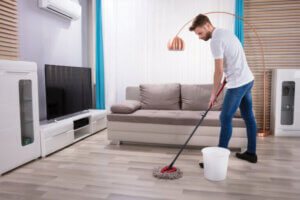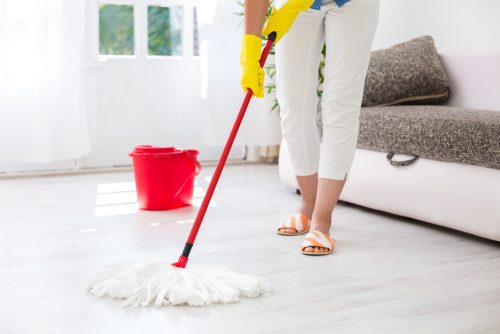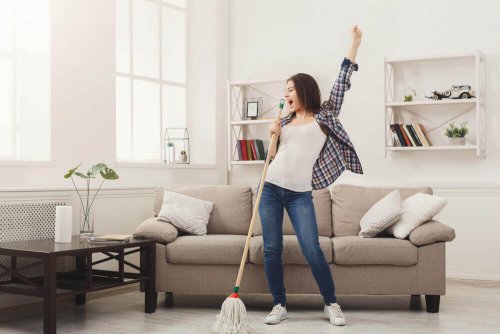How to Prevent Accidents on Wet Floors

Falling over at home is more common than you think. In the same way this can happen to you at work or in a public place, it can also happen at home, so it’s important to know how to prevent accidents at home on wet floors.
Accidents in the home can be dangerous, especially for the elderly or children. Falling over on wet floors can be disastrous. These kinds of falls can break bones or do irreversible damage.
Usually, public areas have to have warnings about the risks, but what happens at home?

Understand the risks
Every time you clean the floor, it takes a while to dry. Someone can come in, not notice the floor is wet, and fall. Therefore, you need to understand the risks that arise with a lack of risk prevention.
What are these risks? First, know what type of floor you have. If you have wooden floors in your home, the risk is lower because they usually absorb dampness and the texture is more resistant to sliding.
On the other hand, wet ceramic flooring can be dangerous. For example, you usually find this material in the bathroom or the kitchen. It’s a very slippery type of floor and can be dangerous if you’re not careful.
If you know your floors and the right way to clean them, you’ll prevent accidents.
Home safety – how to prevent accidents
Once you know the type of floors in your home, it’s time to learn how to clean them and what to do to prevent home accidents. Here are four ways to avoid an accident:
- When cleaning a wooden floor, don’t use bleach, only use water. Otherwise, it’ll take longer to dry and the wood won’t absorb the water. You can also use white vinegar with a little bit of baking soda, to help it dry faster.
- With ceramic floors, people tend to use bleach but, when you use too much, it produces a lot of foam that sticks to the floor. Therefore, measure out one spoonful of bleach for each liter of water.
- To keep the floor from getting too wet, wring the mop. It’ll work better, and when you mop the floor it’ll only leave a thin layer of water that’ll dry more easily.
- Another option is that, after you’ve cleaned the floor, mop the floor again with a dry mop. This will give you a more effective result and prevent accidents.

Preventing accidents at work
Cleaning services at offices, community spaces, and other public places need a prevention system to avoid any kind of accident. Each of these needs a risk assessment to prevent them.
Cleaning staff use signs for wet floors, which is mandatory. These workers also need to use special anti-slip footwear. These are required by law.
At home, people don’t think about these things. However, it would be a good idea to use some form of sign every time the floor’s wet.

An essential aspect of home accident prevention
Lastly, you need to consider a few other important points. On one hand, every time you clean your floors, it’s important to let the rest of the people in the household know, so they’ll know to be careful until the floor has dried.
One way to prevent people from walking on a wet floor is to close the door, hang up a sign, or just letting them know that the floor’s wet. Often, these small actions are the difference between a possible accident and making your home a safer place.
Falling over at home is more common than you think. In the same way this can happen to you at work or in a public place, it can also happen at home, so it’s important to know how to prevent accidents at home on wet floors.
Accidents in the home can be dangerous, especially for the elderly or children. Falling over on wet floors can be disastrous. These kinds of falls can break bones or do irreversible damage.
Usually, public areas have to have warnings about the risks, but what happens at home?

Understand the risks
Every time you clean the floor, it takes a while to dry. Someone can come in, not notice the floor is wet, and fall. Therefore, you need to understand the risks that arise with a lack of risk prevention.
What are these risks? First, know what type of floor you have. If you have wooden floors in your home, the risk is lower because they usually absorb dampness and the texture is more resistant to sliding.
On the other hand, wet ceramic flooring can be dangerous. For example, you usually find this material in the bathroom or the kitchen. It’s a very slippery type of floor and can be dangerous if you’re not careful.
If you know your floors and the right way to clean them, you’ll prevent accidents.
Home safety – how to prevent accidents
Once you know the type of floors in your home, it’s time to learn how to clean them and what to do to prevent home accidents. Here are four ways to avoid an accident:
- When cleaning a wooden floor, don’t use bleach, only use water. Otherwise, it’ll take longer to dry and the wood won’t absorb the water. You can also use white vinegar with a little bit of baking soda, to help it dry faster.
- With ceramic floors, people tend to use bleach but, when you use too much, it produces a lot of foam that sticks to the floor. Therefore, measure out one spoonful of bleach for each liter of water.
- To keep the floor from getting too wet, wring the mop. It’ll work better, and when you mop the floor it’ll only leave a thin layer of water that’ll dry more easily.
- Another option is that, after you’ve cleaned the floor, mop the floor again with a dry mop. This will give you a more effective result and prevent accidents.

Preventing accidents at work
Cleaning services at offices, community spaces, and other public places need a prevention system to avoid any kind of accident. Each of these needs a risk assessment to prevent them.
Cleaning staff use signs for wet floors, which is mandatory. These workers also need to use special anti-slip footwear. These are required by law.
At home, people don’t think about these things. However, it would be a good idea to use some form of sign every time the floor’s wet.

An essential aspect of home accident prevention
Lastly, you need to consider a few other important points. On one hand, every time you clean your floors, it’s important to let the rest of the people in the household know, so they’ll know to be careful until the floor has dried.
One way to prevent people from walking on a wet floor is to close the door, hang up a sign, or just letting them know that the floor’s wet. Often, these small actions are the difference between a possible accident and making your home a safer place.
All cited sources were thoroughly reviewed by our team to ensure their quality, reliability, currency, and validity. The bibliography of this article was considered reliable and of academic or scientific accuracy.
- Lindo Wallace, María Luisa: Técnicas del hogar, San José, Universidad Estatal a Distancia, 1996.
- Rognoni, Patrizia: La limpieza integral de la casa, Barcelona, De Vecchi, 2012.







